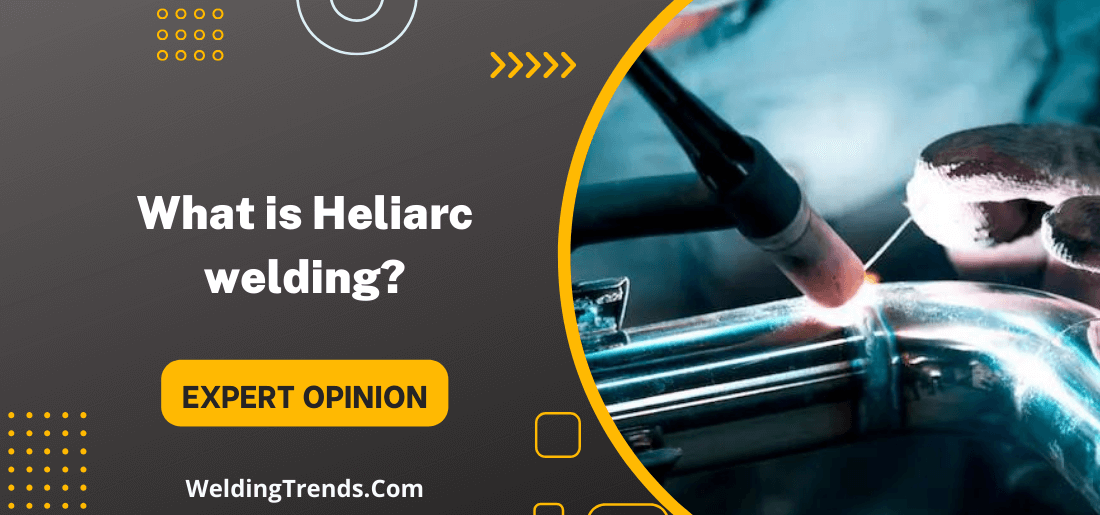Heliarc welding is arc welding that uses an inert gas to shield the weld area from contamination. This type of welding is commonly used in fabrication and repair work. It produces clean and robust welds, making it a popular choice for many applications because of its versatility.
In this blog post, we will discuss the basics of Heliarc welding, its benefits and some tips on how to get the most out of this type of welding.
What is heliarc welding and what are its benefits?
Heliarc welding, also known as gas tungsten arc welding (GTAW), is an arc welding process that uses a non-consumable tungsten electrode to produce the weld. The weld area is shielded from contamination by an inert gas, usually argon. Heliarc welding is commonly used in the fabrication and repair of metals, as it produces clean and strong welds because of its versatility.
There are many benefits to heliarc welding, including:
- The heat produced by heliarc welding is less likely to damage delicate materials.
- The process is extremely versatile and can be used on a variety of materials.
- Heliarc welding is ideal for use in tight spaces or difficult-to-reach areas.
- The process produces very little smoke and fumes, making it a safer option for welders and those working nearby.
- Heliarc welding is extremely precise and can be used to create very intricate designs.
The process is relatively fast and can save time on welding projects. Heliarc welding is a great option for those looking for a high-quality, versatile and precise welding process.
How does heliarc welding work and what kind of equipment is needed?
The basics of heliarc welding are relatively simple. The process uses an electrode made of tungsten, which is a non-consumable metal. This electrode is then used to create an arc between the welding power source and the metals being joined. The heat from this arc melts the metals, which are then fused as they cool. To shield the weld area from contaminants, an inert gas, such as argon, is used.
This gas helps to create a cleaner weld by preventing oxygen and other elements from coming into contact with the weld area and causing corrosion.
To use heliarc welding, you will need a few key pieces of equipment, including:
- A welding power source: This can be either an AC or DC power source. AC is typically used for welding aluminum, while DC is better for welding steel.
- A welding torch: This is used to hold the electrode and direct the gas to the weld area and can be either a water-cooled or air-cooled torch.
- A gas regulator and hoses: This equipment is used to regulate the flow of gas to the welding torch and ensure that the right amount is being used.
- A welding helmet: his is an important safety item that will protect your eyes from the bright arc and flying sparks because the welding process can be quite dangerous.
- Be sure to use the right gas: Using the wrong gas can cause problems with the weld, so be sure to use an inert gas, such as argon, when welding.
- Use the right power source: For welding aluminum, use an AC power source and for welding steel, use a DC power source.
- Be sure to use the right electrode: The welding electrode you use will determine the quality of the weld, so be sure to choose the right one for your project.
- Practice makes perfect: As with any type of welding, practice makes perfect. The more you weld, the better you’ll become at it.
Now that you know the basics of heliarc welding, its benefits and what kind of equipment is needed, you can start experimenting with this type of welding on your projects. With a little practice, you’ll be able to create high-quality welds that are strong and beautiful.
What types of materials can be welded with a heliarc welder?
The versatility of heliarc welding makes it a great choice for a variety of projects. This type of welding can be used on both ferrous and non-ferrous metals, including:
- Aluminum
- Steel
- Titanium
- Copper
- Brass
Heliarc welding can also be used on a variety of different thicknesses of metal, making it a great choice for both thin and thick materials because it can produce high-quality welds on both.
What are the safety precautions that should be taken when using a heliarc welder?
When using a heliarc welder, also known as Tungsten Inert Gas (TIG) welding, safety precautions are paramount to prevent accidents and injuries. This process involves the use of an electric arc and inert gas to weld different kinds of metals, which can create bright light, heat, and dangerous fumes. It is essential to understand and adhere to safety measures to ensure the well-being of the operator and those in the vicinity. Proper personal protective equipment (PPE), adequate ventilation, and knowledge of the equipment’s operation are critical components of a safe welding environment.
- Wear the Correct PPE: This includes a welding helmet with a proper shade for the amperage you are using, fire-resistant clothing, leather gloves, and safety shoes to protect against sparks and hot metal.
- Ensure Adequate Ventilation: Welding can produce harmful fumes that are dangerous to inhale. Use exhaust systems or weld outdoors to ensure there is sufficient air flow.
- Check Equipment Regularly: Before starting, check your welding equipment for any damage or wear. Ensure gas lines are secure and there are no leaks.
- Work in a Safe Environment: Keep your working area free of flammable materials and ensure that you have a fire extinguisher close by. Never weld in damp or wet conditions.
- Use Proper Eye Protection: Even when not welding actively, wear safety glasses to protect against flying debris.
- Be Conscious of Others: Ensure that bystanders or co-workers are also protected or kept at a safe distance from the welding area.
- Learn First Aid: Knowing how to treat burns and eye injuries can be crucial in the event of an accident.
- Follow Manufacturer Instructions: Always use the welding equipment as directed by the manufacturer to prevent misuse that could lead to injury.
- Seek Professional Training: Taking a welding safety course can provide valuable knowledge and skills to ensure safe operation of the equipment.
- Be Mindful of Electrical Hazards: Make sure to turn off the power supply before making any adjustments or repairs on the welding equipment. Otherwise, it could lead to electrocution.
By following these simple safety precautions, you can help to ensure that your welding projects go smoothly and safely.
How to weld metal with a heliarc welder?
There are a few steps that you’ll need to follow to weld metal with a heliarc welder.
- First, you’ll need to set up your work area. Make sure you’re welding in a well-ventilated area and that you have all of the safety equipment you need, including a welding helmet and gloves.
- Next, you’ll need to set up your welder. Be sure to use the correct power source and gas for your project.
- Then, you’ll need to prep your metal. This includes cleaning the metal and removing any paint or rust that may be on it.
- Once your metal is prepped and ready to go, you can begin welding. Start by striking an arc and then moving the electrode along the seam of the metal.
- As you weld, be sure to keep the electrode at a consistent angle and speed. Remember to practice to get the best results.
- When you’re finished welding, be sure to turn off the power and allow the metal to cool before handling it.
By following these simple steps, you can successfully weld metal with a heliarc welder.
FAQs
Is Heliarc welding the same as TIG?
No, Heliarc welding is not the same as TIG welding. While both types of welding use an arc to weld metal, TIG welding uses a tungsten electrode while Heliarc welding uses an arc between the workpiece and a consumable electrode because Heliarc welding uses a higher current than TIG welding.
What gas is used for Heliarc welding?
An inert gas, such as argon, is used for Heliarc welding. This is because using the wrong gas can cause problems with the weld and using an inert gas will help to avoid this.
Can tungsten be welded?
Yes, tungsten can be welded using a Heliarc welder and the correct gas. However, it is important to note that welding tungsten can be difficult and requires a lot of practice to get the best results.
Final Words:
Heliarc welding is a great way to weld metal together. It is a strong and durable type of welding that can be used on many different types of materials. When welding, be sure to take safety precautions and use the correct gas. With a little practice, you can successfully weld metal with a Heliarc welder.
If you are looking for a way to weld two pieces of metal together, heliarc welding may be the right choice for you. We hope this article has helped you learn more about Heliarc welding.




